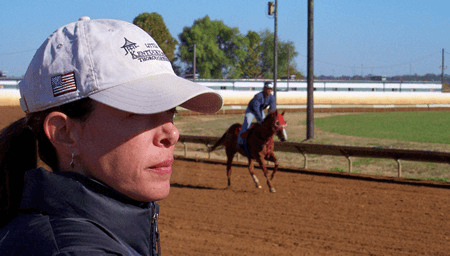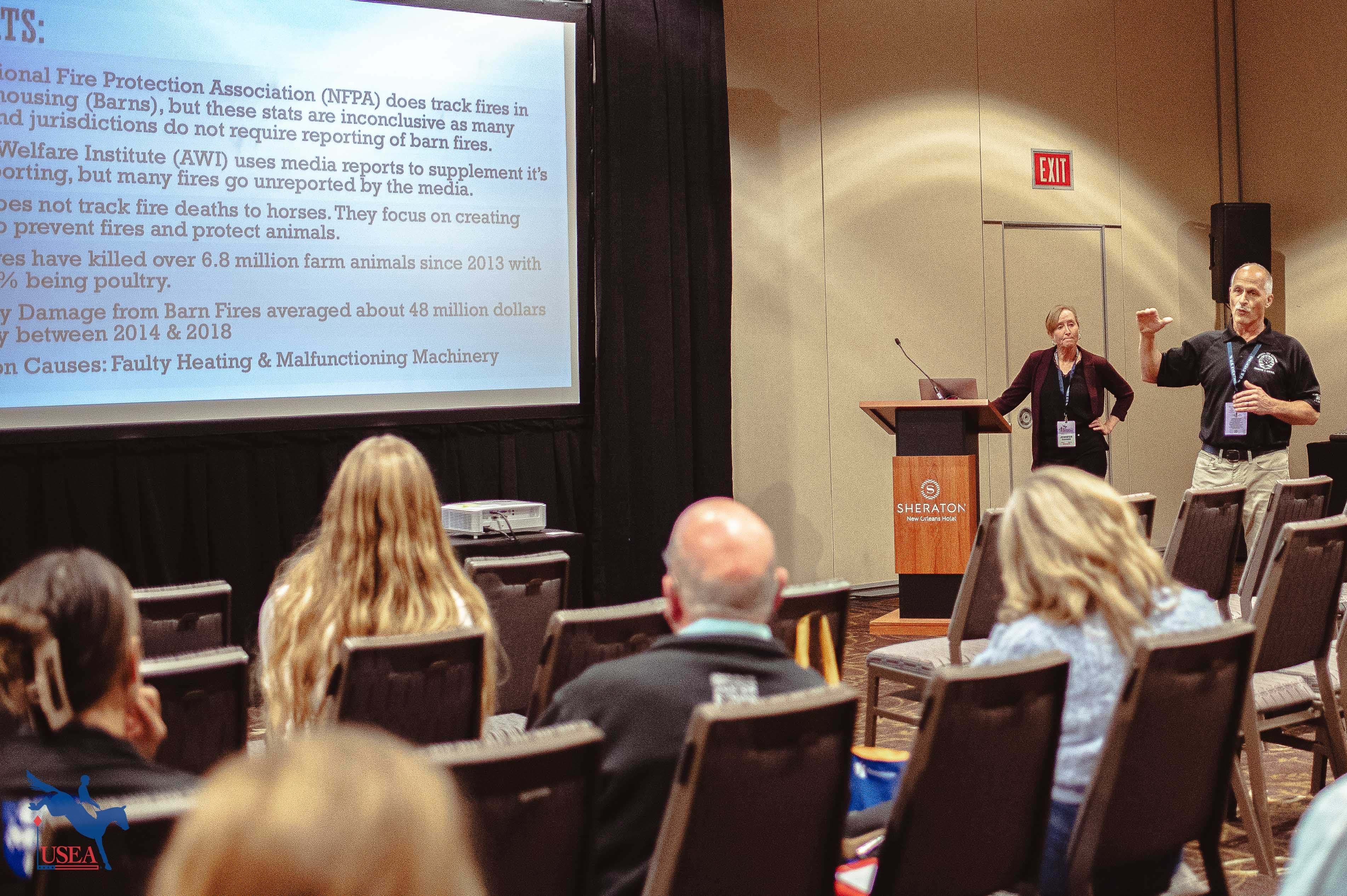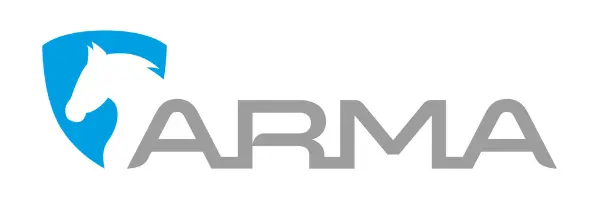I’ve wanted to write something about this subject for a long time, but have always put it on the back-burner or found an excuse to ‘just let it go’. At a show I overheard a conversation of the folks stabling near me (easy to do since one of the women was either slightly tone deft and shouted every word or that she wanted to draw attention to herself and have people believe she was an expert when it came to Thoroughbreds).
The woman proceeded to go in depth into waters that so many people find themselves in when it comes to Thoroughbreds. They either sink to the bottom and drown, or they float effortlessly. This lady sank like a rock. I continued cleaning my tack and made a mental note to later write about this experience.
The 3 things that she talked about are highlighted below, and I’ve hopefully added some information on them for serious consideration.
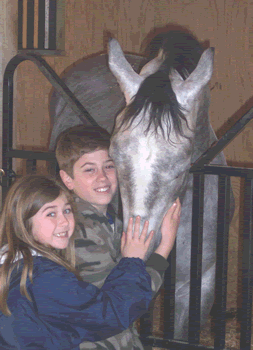
Myth #1: “ALL Thoroughbreds, especially ex-race horses are crazy and difficult to handle”. This was when the woman (let’s call her Betty) stood in the barn aisle, raised an arm in a circular motion and emphasized the word “ALL”. Her audience was spellbound with wide eyes and mouths gaped.
Fact: There is always an argument here that has been debated, simply because negative gossip spreads better than positive gossip. It is NOT true that all Thoroughbreds (especially race horses) are crazy and hard to handle. I’d like people to understand that a Thoroughbred, even before it touches one hoof to the ground, has been designed and developed to do one thing. . . RUN. Owners will go through the tedious process of finding that perfect stallion to breed to, with dreams of red roses floating above their heads. It all looks great on paper.
Once the foal arrives, their destiny has been made. By age 2 they’ve experienced things that a young horse of any other breed would not experience until they’re at least 4 or 5 years old. The Thoroughbred by then has experienced the farrier, loading and hauling on a trailer, cross ties, bathing, tacking up, gate school, traveling to different tracks and dealing with crowds from the stands. These horses are way ahead of other breeds when it comes to their education.
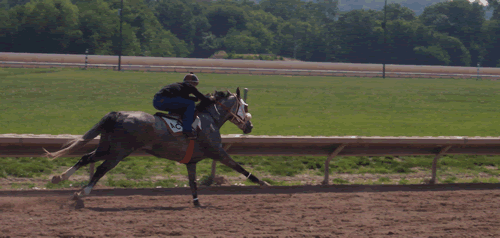
The truth is that Thoroughbreds can be misunderstood because inexperienced horsemen take on an ex-racer without any knowledge of the track. They compare a Thoroughbred with their 14 year old Warmblood, and scratch their heads and wonder why the Thoroughbred doesn’t know how to “collect at the canter”.
People should understand that if a Thoroughbred isn’t making money for it’s owners at the track, they’re usually quickly sold or claimed in claiming races. Amateur owners taking on a young Thoroughbred need to comprehend that it’s a young horse who thinks and behaves like a young horse should. It’s true that you cannot take a young ex-racer and toss them into the show arena and expect to behave like a seasoned show horse. This is when a Thoroughbred gets the bad press and the rumors begin.
If a person gets a young Thoroughbred, it is that person’s responsibility to educate that horse and give it the mileage it needs to become a solid show horse. That means go to as many schooling shows as possible, go trail riding every week, take the horse off the farm and school different cross country courses, find an experienced and accomplished trainer who knows something about Thoroughbreds to work with. – In a nut shell, it’s all about mileage and exposure.
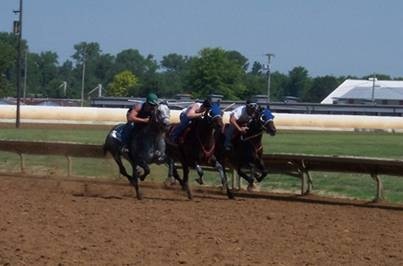
Myth #2: “Thoroughbreds have bad feet”.
Fact: Thoroughbreds at the track have their feet worked on every 2 to 3 weeks depending upon their racing and training schedule. They wear special light weight racing shoes with toe-grabbers. The shape and condition of a race horse’s hoof also depends upon who the farrier may be.
New owners should know that when they take an ex-racer home from the track, that the living conditions at a boarding facility or private farm differ greatly. This will have a huge part in their hooves holding up. First of all (depending upon the track farrier) you’ll find some horses having low or under-run heels. This is when the shoes were not placed under the heel of the hoof for enough support. The pounding from galloping also pushes the heel wall downward. With the toe-grabbers being higher than the rest of the shoe, it also will rock the horse back on to it’s heel. This makes the horse appear to have long toes and does play a part in the horse developing under run heels if not properly maintained.
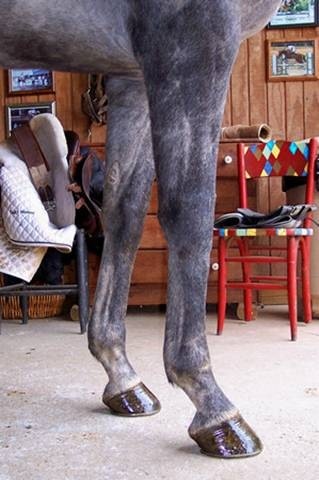
A horse coming off the track needs to adjust to a heavier shoe, and possibly clips. Some people think that they can get a horse and take their shoes off all together to allow their feet to ‘harden up’. They soon discover they have a 4-legged lame Thoroughbred. I always tell folks to please keep the horse’s in shoes. You’re going to avoid a lot of problems.
Something as simple as turn-out time in the pasture can cause issues. At the track the horses aren’t exposed to damp or wet footing and stand in their straw bedded stalls. Turning out a Thoroughbred in the morning in a dewy wet pasture will make their feet expand, and taking them in to have them stand in a stall of shavings or dry surfaces make their feet contract. Riding in a sand arena will also pull any moisture out of their feet.
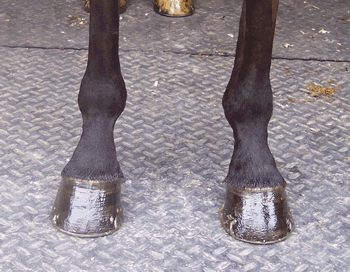
A heavier shoe with clips will not only make the horse move differently, but if the clips are too tight, can squeeze the hoof wall making their feet sore. Damp footing will make their feet expand and nails holes open up so that it’s easy to loose shoes. Dry sandy footing makes the hooves shelly and brittle and break-up. This can happen to any breed of horse, not just Thoroughbreds.
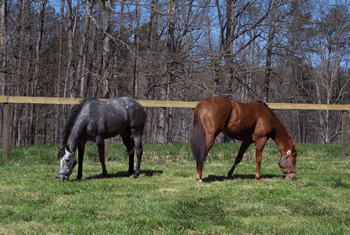
I ask owners to be aware of the weather, don’t ride on hard surfaces, make sure your farrier is qualified and is experienced, and do the maintenance that you would have to do on ANY equine. In the Summer, a horse should be shod around every 5 weeks (hooves grow faster in Summer) and every 6 weeks in Winter. Use a hoof dressing for the outside walls once a week in the summer. * A great grooming trick is to paint their hooves with hoof dressing BEFORE hosing them off with water. This will make the water bead-off their feet rather than soaking into the nail holes and making the hoof expand. Watch out for thrush and keep a bottle of Thrush-Buster in your medicine cabinet. Another trick I do is keep a box of toilet wax sealer handy. This is what a plumber uses when installing toilets to the floor. The wax is soft so that I can dip my finger into it and then plug it into nails holes and cracks around the hoof wall. It seals any gaps and helps keep water out of the hoof.
Myth #3: “Thoroughbreds are hard to put weight on and are not easy keepers”. I have seen fat Thoroughbreds and I have seen skinny Thoroughbreds. Their body types depend upon a variety of things. For instance, feed and hay quality – It’s quite simple . . . the better the feed and hay, the better the results you’re going to get when your horse eats it!” Other factors include daily maintenance of the horse. If you take care of your investment, it’ll most likely payoff. Some Thoroughbreds will have a quiet personality and some will be more active.
Fact: At the track the horses are fed heavy amounts of grain and are given enormous hay bags of hay (usually an alfalfa mix) or wide bladed grass (fescue, timothy). Take the horse home and toss them different feed and hay, you end up wondering why they stomp on the hay and use it as bedding. Often, they’ll leave their feed in the bucket.
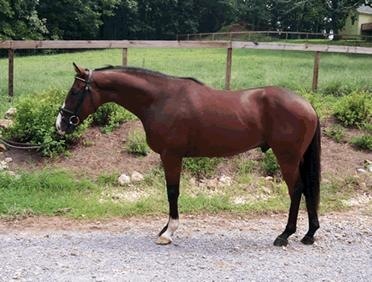
A few reminders should take place with a new Thoroughbred and one of the first should be calling an Equine Dentist. Caring for their teeth will help them chew and digest their food properly and assist in weight gain. Young horse’s mouths are constantly changing. They will be either loosing their baby teeth and/or breaking in new teeth. For young Thoroughbreds between the ages 2 to 5, I usually have the dentist come every 6 months, sometimes more. The older Thoroughbreds have their teeth looked at once a year.
Next, look into your feed. Make sure you give something that is high in fat content and
low in sugar or carbs. You will not feed in the same amounts that they’re accustom to having. You’ll feed a lot less grain. Try to stay away from pellets because when they break down, they don’t have the same roughage that a grain would and can give a horse loose manure. You can add fat to your grain by adding rice bran twice a day and some corn oil.
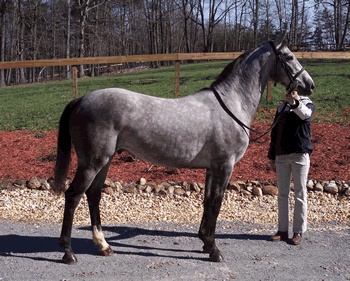
Avoid giving Bermuda or Coastal hay. It’s not as nutritional as a fescue mix or an alfalfa mix. Their blades are also extremely thin and could likely ball up in their digestive tracks, causing impaction’s which leads to colic. Consider a hay rack to toss your hay and keep it off the ground. That will save you money. Give your new Thoroughbred time to adjust to their new surroundings. It might take a few days for them to understand their new feeding time and turn out time. But whatever folks do, please don’t take their food away. Give them the time to eat.
At turnout the Thoroughbred needs a chance to investigate their new surroundings. Some people become a bit nervous when they notice their new horse not grazing like the others. I tell them to just give the horse time and they will go back to their instincts and remember what grass is. Have an understanding that their body types and metabolism differ from other breeds. Thoroughbreds are meant to have sleek bodies for racing. They’re the Grayhounds of the equine industry and will never look like a fat Saint Bernard. If their metabolism is low, then you’re lucky, because putting on weight will come easy. It’s always a good idea to talk to your vet about feed for your young horse.
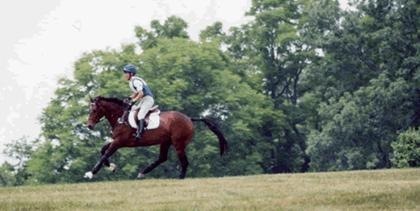
Just like their teeth, their bodies will be constantly changing due to quality of feed and hay, the level of training and exercise and from aging. Always consult with your vet as to what to feed your horse, and stick to the program. I ask owners to stick to the basics and remember horses (not just Thoroughbreds) are creatures of habit. Give them time to gain weight, give them time to mature and grow, and most important, be sure that if you increase their training, that you must increase their food intake!
It’s true that Thoroughbreds are not for everyone. But if you’re a die-hard Thoroughbred Lover, there’s never turning back – there’s just the finish line.

